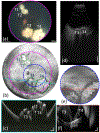Panretinal Optical Coherence Tomography
- PMID: 37216244
- PMCID: PMC10615839
- DOI: 10.1109/TMI.2023.3278269
Panretinal Optical Coherence Tomography
Abstract
We introduce a new concept of panoramic retinal (panretinal) optical coherence tomography (OCT) imaging system with a 140° field of view (FOV). To achieve this unprecedented FOV, a contact imaging approach was used which enabled faster, more efficient, and quantitative retinal imaging with measurement of axial eye length. The utilization of the handheld panretinal OCT imaging system could allow earlier recognition of peripheral retinal disease and prevent permanent vision loss. In addition, adequate visualization of the peripheral retina has a great potential for better understanding disease mechanisms regarding the periphery. To the best of our knowledge, the panretinal OCT imaging system presented in this manuscript has the widest FOV among all the retina OCT imaging systems and offers significant values in both clinical ophthalmology and basic vision science.
Figures








References
-
- Koulisis N et al., “Correlating Changes in the Macular Microvasculature and Capillary Network to Peripheral Vascular Pathologic Features in Familial Exudative Vitreoretinopathy,” Ophthalmol. Retina, vol. 3, no. 7, pp. 597–606, Jul. 2019. - PubMed
-
- Blair JP, Ulrich JN, Hartnett ME, and Shapiro MJ, “Peripheral retinal nonperfusion in fellow eyes in coats disease,” Retina, vol. 33, no. 8, pp. 1694–1699, Sep. 2013. - PubMed
-
- Wang SK, Callaway NF, Wallenstein MB, Henderson MT, Leng T, and Moshfeghi DM, “SUNDROP: six years of screening for retinopathy of prematurity with telemedicine,” Can. J. Ophthalmol, vol. 50. no. 2. pp. 101–106. Apr. 2015. - PubMed

